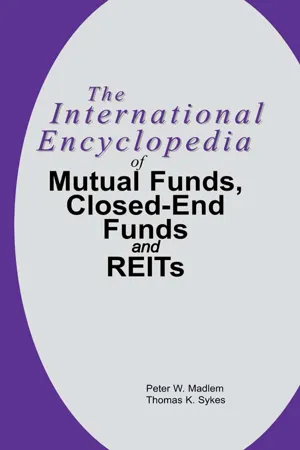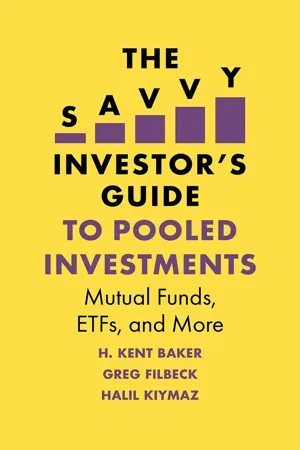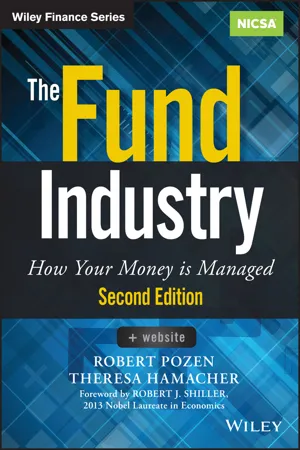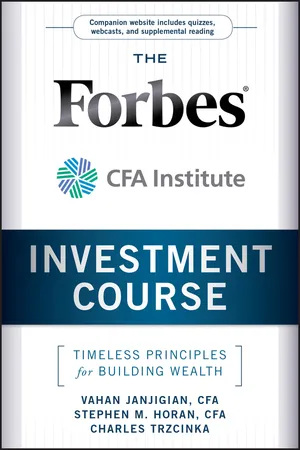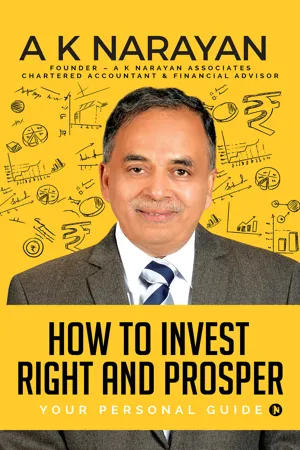Economics
Mutual Funds
Mutual funds are investment vehicles that pool money from multiple investors to buy a diversified portfolio of stocks, bonds, or other securities. They are managed by professional fund managers who make investment decisions on behalf of the investors. Mutual funds offer individual investors the opportunity to access a diversified portfolio and professional management, making them a popular choice for long-term investment.
Written by Perlego with AI-assistance
Related key terms
Related key terms
1 of 4
Related key terms
1 of 3
10 Key excerpts on "Mutual Funds"
- eBook - ePub
Regulation and Governance of Mutual Funds
United Kingdom and United States of America Perspectives on Investor Protection
- Mohammed Khair Alshaleel(Author)
- 2022(Publication Date)
- Routledge(Publisher)
6 Both definitions stress the idea of pooling money from a large number of investors to be managed by a professional manager, according to the fund objectives.5 Haslem (n 1) 4.6 M Mobius, Mutual Funds: An Introduction to the Core Concepts (John Wiley & Sons, Hoboken 2007) 1.Thus, a mutual fund can be defined as a common pool of money into which investors put their funds to be invested in accordance with an agreed objective by professional management. It offers, in addition to diversification, liquidity, by standing ready to redeem its shares at net asset value (NAV).7To diversify their portfolios, Mutual Funds generally invest their assets in equities, bonds, derivatives, deposits and near-cash assets, short-term money market instruments, or a mix of these investments.8This definition, like those aforementioned, attempts to show the main features of Mutual Funds (Figure 2.1 ).7 G P Mahoney, ‘Manager-Investor Conflicts in Mutual Funds’ (2004) 18 Journal of Economic Perspectives 161–182.8 Haslem (n 1) 8.Figure 2.1 How Mutual Funds typically work.Generally, Mutual Funds around the world are created in different organisational forms. First, the corporate form, where a mutual fund is usually treated as a separate entity. Second, the contractual form or the trust structure, where a mutual fund is established as a trust managed by a trustee for the benefit of the investors.9 - Peter W. Madlem, Thomas K. Sykes(Authors)
- 2014(Publication Date)
- Routledge(Publisher)
A mutual fund is an investment company, a corporation, or trust whose sole business is to make investments on behalf of individuals and institutions sharing a common investment goal. A fund endeavors to do a better job of investing participant funds and managing the investments than individual investors could do for themselves.The funds that form the mutual fund investment pool come in varying amounts from many different investors. The fund managers then use the pool of money to buy a portfolio of stocks, bonds, or money market securities intended to achieve the fund’s financial objectives.While a mutual fund is simply one method of investing, many consider them to be the best investment medium developed in the twentieth century. There are an abundance of investment products, but none match the flexibility and versatility of Mutual Funds. Mutual Funds offer professional management, liquidity, ease of record keeping, diversification, and lower risk—all in one investment package.The investment objectives of Mutual Funds cover a wide range. There are Mutual Funds to invest in all types of investments, including: • common stocks; • preferred stocks; • corporate bonds; • tax-free municipal bonds; • U.S. Government obligations; • zero-coupon bonds; • convertible securities; • gold and silver; • foreign securities; and • real estate.A mutual fund’s investment objective, found in the prospectus, determines how fund assets are invested. Some seek higher returns by following, risky aggressive investment strategies; others pursue current income using more conservative investments. Management will rely on fundamental, macro- or micro-economic conditions and even technical analysis to arrive at a suitable portfolio composition.One major attraction of Mutual Funds is that there are many funds offering the same investment strategy to select from. For example, an individual needing high current income has a lot of bond funds to choose from. An investor might even consider an equity fund and withdraw funds on a systematic basis either monthly or quarterly. An investor desiring growth in assets would look to the various stock funds ranging from aggressive growth to growth and income or may even consider international stock funds. An investor can also mix and match several Mutual Funds in order to achieve some current income plus inflation protection via bond and equity funds. Some Mutual Funds, called balanced or asset allocation funds offer this ability internally- eBook - ePub
The Savvy Investor's Guide to Pooled Investments
Mutual Funds, ETFs, and More
- H. Kent Baker, Greg Filbeck, Halil Kiymaz(Authors)
- 2019(Publication Date)
- Emerald Publishing Limited(Publisher)
Dutch merchant Adriaan van Ketwitch formed the world’s first mutual fund in 1774 by pooling money from a limited number of investors. The fund diversified across European countries and the American colonies through the backing of income from plantations. The subscription to the fund was called “unity creates strength” and was limited to 2,000 units. The fund survived until 1824, but the concept of pooling money to create PIVs continues today. The first mutual fund in the United States, Massachusetts Investors Trust, was created in 1924. The fund grew from $50,000 to $392,000 in assets in one year. It became available to the public in 1928 and later became MFSA Investment Management. In 1940, the United States had 68 Mutual Funds, but this number had grown to 9,356 by 2017, with net assets under management (AUM) of almost $19 trillion.The purpose of this chapter is to provide the necessary background to help you decide whether Mutual Funds should be part of your investment portfolio. Although Mutual Funds are extremely popular and investing in them appears straightforward, as a savvy investor, you should continue to educate yourself to stay at the top of your game and to obtain the most from your investments. The following questions and answers should help guide you to meet this challenge involving Mutual Funds.1.1. WHAT IS A MUTUAL FUND AND HOW DOES IT WORK?
A mutual fund is an investment company that pools money from investors to buy securities and assets in financial markets according to the objectives specified in the fund’s prospectus. In finance, a prospectus is a formal legal document that provides details about an investment offering for sale to the public. With a mutual fund, you’re entrusting your savings to professional fund managers. The underlying securities and assets in a mutual fund represent its portfolio. Legally known as an “open-end” fund (OEF) or company, a mutual fund is one of three basic types of investment companies. The other two are “closed-end” funds (CEFs) and unit investment trusts (UITs), which are discussed in Chapters 3 and 4, respectively.Mutual Funds give people the sense that they’re investing with the big boys and that they’re really not at a disadvantage entering the stock market. Ron ChernowAn important characteristic of a mutual fund is its ability to offer new shares to investors. A mutual fund stands ready to sell additional shares to investors and to buy and redeem shares from anyone who wants to sell. When you buy shares, the fund issues them, and then invests the money received. When you sell shares, the fund either uses existing cash or sells some of its assets and uses the cash to redeem your shares. As a result, the number of shares outstanding changes over time, and no limit exists on the number of shares that the fund can issue. Mutual Funds price their shares each business day, typically after the major US exchanges close. The cost of each share is calculated as the fund’s net asset value (NAV) per share, which is computed by dividing the difference between the portfolio’s market value and any fund liabilities by the number of shares outstanding. You buy and sell shares based on a fund’s NAV per share. This price fluctuates based on the value of the securities held by the portfolio at the end of each business day. However, you don’t actually own the securities in which the fund invests; you only own shares in the fund itself. - eBook - ePub
The Fund Industry
How Your Money is Managed
- Robert Pozen, Theresa Hamacher(Authors)
- 2015(Publication Date)
- Wiley(Publisher)
in a fund. That's because a mutual fund isn't really an investment itself; it's just an intermediary—a financial intermediary.Mutual Funds have made it easy for individuals (you, me, and anyone with money to invest) and institutions (corporations, foundations, pension funds) to pool their money to buy stocks, bonds, and other investments. A fund is mutual because all of its returns—from interest, dividends, and capital gains—and all of its expenses are shared by the fund's investors.Funds offer investors advantages over buying and selling securities directly, including:- Reduction of risk by investment diversification.
- Ability to sell your investment daily.
- Access to the expertise of professional money managers.
- Ability to participate in investment strategies that might not otherwise be available to smaller investors.
- Administrative convenience and shareholder services.
- A high level of investor safeguards.
- Comprehensive reporting that enables easy comparisons among funds.
These benefits have proven to be very popular with investors around the world; they held a total of $30 trillion in fund assets at the end of 2013. U.S. households now put more of their money into Mutual Funds than they do directly into stocks, making Mutual Funds an integral part of financial planning for many people.2 We describe a few typical fund buyers in “Mutual Fund Investors.”Mutual Fund Investors
Are you—or is someone you know—like one of these typical mutual fund investors?- A middle-aged couple looking to retire sometime in the next 10 to 15 years. He works for a technology company, while she runs her own consulting business. They're building a retirement nest egg by investing in stock Mutual Funds through his company's 401(k) plan and her individual retirement account.
- A grandmother who wants to help finance the college tuition of her two infant granddaughters. She opens college savings accounts for both, planning to make annual contributions. She puts the assets in each account into a balanced mutual fund that holds a mix of stocks and bonds.
- eBook - ePub
- Paul A Tucci(Author)
- 2014(Publication Date)
- Visible Ink Press(Publisher)
THE BASICS What is a “mutual fund”? A mutual fund is a professionally managed investment vehicle that pools funds from many investors and collectively invests them in stocks, bonds, cash instruments, commodities, other Mutual Funds, real estate, and many other types of investment instruments. A mutual fund enables its investors to gain (or lose) from the fund’s performance. How much money flowed into U.S. equity Mutual Funds and exchange traded funds in 2013? According to experts at TrimTabs Investment Research in a report published in January 2014, a record $352 billion flowed into U.S.-listed equity Mutual Funds and ETFs in 2013, breaking the previous record inflow of $324 billion set in 2000. What about the success of high-performing Mutual Funds? Experts at Forbes magazine cite a 2003 study by mutual fund analysis company Morningstar that looked at a 20-year period beginning in 1976, analyzed the returns in five four-year periods, and compared the returns of the best 30 funds in each of those periods against the performance of those same funds over the next period. They found that the star funds did very well during the first period, averaging a return of 28.3%, but in the next period, not only did many of these same funds drop out entirely, but those that remained had returns of only 1.8%. This data is relatively easy to find. When did Mutual Funds start? Many believe the first Mutual Funds were organized in Northern Europe, specifically in the Netherlands, by King William I in 1822. Others cite 1774, when a Dutch merchant named Adriaan van Ketwich created Eendragt Maakt Magt, which means “unity creates strength.” He may have influenced King William I to create his fund some years later. According to academic researchers at Yale University, Ketwich sought investors and invested primarily in bonds (debt) of such countries as Austria, Denmark, “German States”, Spain, Sweden, Russia, and colonial plantations of Central and South America - eBook - ePub
The Forbes / CFA Institute Investment Course
Timeless Principles for Building Wealth
- Vahan Janjigian, Stephen M. Horan, Charles Trzcinka(Authors)
- 2011(Publication Date)
- Wiley(Publisher)
Mutual Funds offer a number of advantages to investors. They provide small investors with access to professional portfolio management services that would normally be out of their reach, as well as access to a highly diversified investment portfolio. Investing in Mutual Funds can simplify record-keeping and administrative activities. There are many different kinds of Mutual Funds available that employ all kinds of investment strategies, styles, and asset allocations. It is not difficult to find one that suits your goals and needs.Mutual Funds are also known as investment companies. The investment company uses the services of a professional portfolio manager to make investments that are consistent with its goals and mandates. When you invest in a mutual fund, you buy shares representing partial ownership of the fund’s securities. As a shareholder, you share in the fund’s gains and losses and pay your part of the fund’s expenses. There are two main fund categories: equities and fixed-income securities. Each category has numerous subcategories. When choosing a fund, focus on the assets the fund holds, the level or risk associated with the fund, and the geographic focus of the fund. You should also consider the fees charged by the fund. A fund with high fees must outperform the market by a wide margin in order to justify its existence.In some ways, hedge funds are similar to Mutual Funds. For example, they both pool clients’ funds. However, hedge funds are subject to much less regulation. In addition, only accredited investors may invest in hedge funds. To be accredited, the investor must have a high net worth or income. Hedge funds typically have large minimum investment requirements, and they usually place limitations on when money can be withdrawn.Mutual Funds are fine for some people, but there are also many disadvantages associated with them. For example, they are not necessarily tax-efficient, and many actively managed Mutual Funds underperform the market indexes. Some funds have high expense ratios and hold too many securities. Others fail to provide adequate diversification even though there are regulations in place designed to prevent funds from becoming too concentrated. Information about fees, expenses, and performance are readily available in the fund prospectus. With your investment goals and needs in mind, you can make informed decisions about which funds are right for you. - eBook - ePub
How to Invest Right and Prosper
Your Personal Guide
- A K Narayan(Author)
- 2022(Publication Date)
- Notion Press(Publisher)
Mutual FundsA mutual fund is a trust that collects the savings of investors and invests them in the mandated investment products on their behalf. The mutual fund makes investments based on the goals or objectives of the investors and generates returns which can be distributed back to the investors. Any investor with surplus money, even small amounts, can invest in Mutual Funds. Units of the mutual fund scheme are allocated to the investors called unitholders based on the investments made. These can be redeemed by the investors when needed. A mutual fund is an investment option for retail investors offering an opportunity to invest in a diversified and professionally managed scheme at a low cost.The management structure of Mutual Funds consists of the following entities for managing the unit holders’ funds:1. Sponsors2. Trustees3. Asset Management Company (AMC)4. Transfer Agents5. CustodianA mutual fund is a set up in the form of a trust established by a sponsor who is like the promoter of a company.Trustees hold the assets and act as the protectors of the interest of the unitholders. They are expected to oversee the working of the AMC. Trustees also ensure that SEBI regulations are followed by the AMCs.The AMC is approved by SEBI, and they need to get the clearance from SEBI before launching any scheme. The custodian, registered with SEBI, holds the securities of various schemes of the fund in its custody.Transfer Agents take care of investor requirements and send statements to investors after every investment is made. The person managing the investors’ money in the mutual fund scheme is called the fund manager. - eBook - ePub
- Tony Martin, Eric Tyson(Authors)
- 2020(Publication Date)
- For Dummies(Publisher)
All too often Canadians end up disappointed with their funds’ performance, because they’ve been sold something that’s either unsuitable or just too expensive. It’s a shame, because building a portfolio of excellent funds is easy if you follow a few simple rules and use your own common sense. This stuff isn’t complicated — a mutual fund is just a money-management service that operates under clear rules. Yes, it involves a lot of marketing mumbo-jumbo and arcane terminology, but the basic idea could be written on a postage stamp: In return for a fee, the people running the fund promise to invest your money wisely and give it back to you on demand. The fund industry is competitive and sophisticated, which means plenty of good choices are out there. This chapter shows how funds make you money — especially if (only if!) you leave your investment in place for several years. It also touches on the different types available and describes the main places you can go to buy funds. Beginning with Mutual Fund Basics A mutual fund is a pool of money that a company gets from investors like you and divides up into equally priced units. Each unit is a tiny slice of the fund. When you put money into the fund or take it out again, you either buy or sell units. For example, say a fund has total assets — that is, money held in trust for investors — of $10 million and investors have been sold a total of 1 million units. Then each unit is worth $10. If you put money into the fund, you’re simply sold units at that day’s value. If you take money out, the fund buys units back from you at the same price. (Handling purchase and sale transactions in units makes it far simpler to do the paperwork.) And the system has another huge advantage: As long as you know how many units you own, you can simply check their current price to find out how much your total investment is worth - eBook - ePub
- Bryan Borzykowski, Andrew Bell(Authors)
- 2024(Publication Date)
- For Dummies(Publisher)
In this chapter, we show how funds make you money — especially if you leave your investment in place for several years. We also touch on the different types available, and quickly describe the main places you can go to buy funds. We discuss these topics in greater detail throughout the book, but after you read this first chapter, you’ll know the basics.Getting the Scoop on Mutual Fund
A mutual fund is a pool of money that a company gets from investors like you and me and divides into equally priced units . Each unit is a tiny slice of the fund. When you put money into the fund or take it out again, you either buy or sell units.For example, say a fund has total assets — that is, money held in trust for investors — of $10 million and investors have been sold a total of 1 million units. Then each unit is worth $10. If you put money into the fund, you’re simply sold units at that day’s value. If you take money out, the fund buys units back from you at the same price. (Handling purchase and sale transactions in units makes it far simpler to do the paperwork.) And the system has another huge advantage: As long as you know how many units you own, you can simply check their current price to find out how much your total investment is worth. So, if you hold 475 units of a fund whose current unit price is $15.20, then you know your holding has a value of 475 times $15.20, or $7,220.Owning units of a mutual fund makes you — you guessed it — a unitholder . In fact, you and the other unitholders are the legal owners of the fund. But the fund is run by a company that’s legally known as the fund manager — the firm that handles the investing and also deals with the fund’s administration.The terminology gets confusing here because the person (usually an employee of the fund manager) who chooses which stocks, bonds, or other investments the fund should buy is also usually called the fund manager. To make details clear, we refer to the company that sells and administers the fund as the management company or fund sponsor . We use the term fund manager - eBook - ePub
- Kathy Kristof(Author)
- 2010(Publication Date)
- Bloomberg Press(Publisher)
8Mutual FundsDon’t have the time, skill, or interest to pick individual stocks? There’s no need to give up on investing. You can get a professional to do the stock picking for you. The easiest and least expensive way to do that is to build a portfolio of Mutual Funds. If you choose funds wisely, not only can you save time, you can also enjoy steady returns.But first, a little deprogramming may be necessary for those who frequent magazine stands. There are no “Best Funds to Buy Now.” There is no one-size-fits-all “Fund Portfolio for the New Millennium.” Indeed, the hottest funds of today are frequently the coldest funds of tomorrow. Buy them at your economic peril. “There is more risk of loss when you buy a fund that’s at the top of the performance charts than there is when you buy a fund at the bottom,” says A. Michael Lipper, chairman of Lipper Inc., a mutual fund information and ranking service based in New York.So how do you pick good funds? First, a little background on Mutual Funds is required.WHAT IS A MUTUAL FUND?
Mutual Funds are investment pools that collect money from many investors and use it to buy stocks, bonds, and other investments. The type of securities the fund buys is spelled out in a detailed investment document called a prospectus. Each investor owns a pro-rata share of the assets in the pool.The fund company employs an investment manager, who chooses the specific stocks or bonds to buy and sell based on criteria spelled out in the prospectus. “Open-end” Mutual Funds—which make up the bulk of the industry—also calculate the value of the pool’s investment holdings each day, divide that by the number of shares owned by individual investors, and report the result—the net asset value of each share. Most of these net asset values are reported in major newspapers each day, just like the prices of individual stocks. You can also get mutual fund quotes on financial websites, such as Yahoo! Finance (see “Finding Financial Data on the Web,” in Chapter 5). In addition, many major fund families also provide these quotes on their websites.
Index pages curate the most relevant extracts from our library of academic textbooks. They’ve been created using an in-house natural language model (NLM), each adding context and meaning to key research topics.
Explore more topic indexes
Explore more topic indexes
1 of 6
Explore more topic indexes
1 of 4

